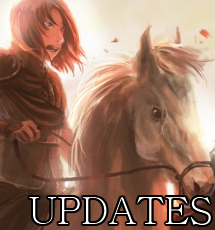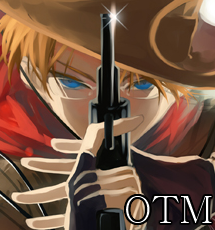Post by The Game Master on Jun 1, 2013 15:02:36 GMT -8
Dragons
Sentient flying reptiles that are often regarded as some of the oldest and most intelligent beings on the planet. Though normally xenophobic (and for good reason, as many people choose to hunt them), they are known to selectively allow certain beings to continuously exist alongside them (these are called “dragon tamers”).
Dragons can live for centuries, even millennium. Extremely territorial creatures, they will shoot down anything that invades the sky in order to maintain their control. Their fire is hot enough to burn the flesh off the bones of any living creature. Their jaws are their strongest weapon, filled with viciously sharp teeth. Their wings can stretch to twice the size of their body or longer, and are often leathery to the touch, but are thin and fragile. They have the ability to communicate with humans through a form of mental speech, but it is often unlikely that a dragon will bother reaching out to talk.
Many people mistake dragons as violent, irrational, and stupid, but this is a false notion. Dragons are among the most intelligent and sensible creatures in the world. Their brains are highly developed and some of the ideas thought up by dragons are incomprehensible to humans, whose brains cannot yet grasp the concepts. Dragons are often found hoarding books along with gold (if any gold is hoarded at all), and are completely literate. As an egg, they can pick up any language and dialect that they hear regularly and speak it upon hatching, as well as the language of dragons, known from birth.
Similar to humans, dragons have the capability of being greedy or nasty to others. Though wise, there have been many a malicious dragon in history, just like humans. Most of the time, dragons lash out only when threatened or when their habitat is invaded upon, but are also susceptible to wrath, pride, gluttony, laziness, and envy. Normally patient creatures that are willing to talk through an issue, in recent times, the fear of being murdered has led to dragons making more quick and irrational decisions in order to preserve their lives.
Dragons are often hunted. Part of this is due to the sheer hatred and fear that many hold, and other reasons involve the money that can be made off selling parts of a dragon. Dragon scales are stronger than the strongest metal and their teeth are sharper than razors, used for armor and weapons respectively. Their claws and horns can be pounded into a fine powder that has special magical properties and is often used in magical elixirs and medicines, but are also ridiculously sharp. Their bones are strong and can be carved into formidable weapons or useful tools. Dragon blood is often used in medicines or potions due to high magical qualities.
Dragon eggs are incredibly difficult to find. Female dragons do not often produce more than one egg every decade of their life once they've reached maturity (at approximately 7 years of age), and these eggs must be fertilized before they are laid to prevent complete decomposition, which takes merely a month of time to happen, ensuring no other creature can get a hold of them. The biodegradable matter can be consumed by other creatures, as they are very rich sources of iron and zinc.
Eggs come in a wide array of colors, of which the dragon's scales will usually take after. They're precious, beautiful, rather heavy, and very expensive, rather popular adornments in rich households. These eggs are only available through the black market, or are given to a prospective tamer by a master. The eggs that are found in the houses of nobles, however, are "dead", or unlikely to ever hatch. The shells of dragon eggs are usually warm to the touch, but "dead" eggs will be cold. These eggs, though this is an unknown fact to most everyone but tamers, can be revived by putting it in dragon fire, or some other very large one (though dragon fire has the most success).
Often, for a dragon to hatch and grow up successfully, the mother dragon stays with the egg. If the mother is not there, the dragon may hatch, but it is unlikely to survive past the first week without someone to care for it. Most of the time these eggs do not hatch, and eggs with the potential to still hatch need some sort of encouragement to do so.
Dragons are very quick to mature in the mind but take much longer to grow in body. The first year of their life is spent eating copious amounts of meat, seven times a day, and sleeping for long periods of time. The one year mark is when dragons start to develop their flight and the muscles in the wings fully form. They double in size. The ability to speak aloud is fully developed. Half way into their first year, dragons will start to develop their fire breathing abilities, which start out as streams of smoke rising out of their nostrils. Their mothers leave them to fend for themselves. By their second year, they are able to spit small flames, and by their fourth year their fire is formidable enough to cause damage and are big enough to carry someone. As they grow older, the strength of their flame and the length of time they are able to spew it increases.
Dragons never truly stop growing. They hit maturity, but that only signifies when they can begin to produce offspring. The growth drastically slows down after maturity though, and there is no visible change for long periods of time. It sometimes takes a decade for a dragon to increase in size by even couple feet.
At certain points in their lives, specifically before maturity, dragons will molt. Each molting reveals a more resistant set of scales. The oldest dragons in the world have the hardest scales and most, if not all, weapons will be unable to penetrate them, save another dragon's claws. Their teeth and claws are easily replaceable—dragons are predators that will sometimes lose teeth or claws during a hunt and a new one will always move forward to take its place. However, dragons stop replacing scales at a certain age, though that age is completely unknown. The inability to replace scales leaves chinks in the armor that, if found, may be penetrated by weapons, thus killing a dragon.
The diet of a dragon is carnivorous save for blueberries, which are delicacies and treats among the species. As the berries are small and often easily confused with poisonous ones, dragons rarely gather blueberries themselves, instead sticking red meat; if there is a tamer or human friend around, dragons will usually ask them to gather the blueberries. When hunting, dragons like to swoop down from the sky and grab their prey, then carry it off to a different area to eat. Other hunting methods include stalking prey, trapping it, and trickery. Dragons eat the entire animal—skin, bones, and all—unless sick, chased away, or they abandon it for an unknown reason. Their eyes are keener than hawks and they can spot movement miles away. Not only are their eyes keen in the day, they are keen at night as well, so if need be, they can hunt at night.
Male dragons are, by rule of nature, bulkier and heavier. They look dangerous, are aggressive, and quick to anger. Less likely to be patient, male dragons, especially the young ones, are difficult to reason with, and there is often fighting between two male dragons over territory or a mate. These fights can get so explosive that they can burn down miles and miles of forest in the process. As they age, male dragons become calmer, and their fiery period can be seen as similar to the teenage years of human males.
Female dragons are more rational, much calmer. They have significantly less bulk than the males, but they make up for it with speed. Female dragons are more social than male dragons, but the fights that happen between female dragons are much more ferocious than males. Between male dragons, the loser will slink away to lick his wounds. Between females, only one will get out alive. Female dragons are much more protective, especially when they have young to care for. Females, when feeling threatened by a male dragon, will lash out to show her discomfort. Males, unless they are being particularly cocky, will take the cue to leave. Those that do not are not are chased away.
Males are rarely allowed near offspring, as they are sometimes considered as potential rivals and are likely to be slaughtered. Only the dragon that fathered the young are allowed near them. Females will sometimes gather together to let their young play with each other, but these gatherings only exist in places where a society of dragons can be maintained without risk of their children being slaughtered.
Take note that if you find a dragon carcass, get as far away from the area as fast as possible. Only danger can lurk nearby.
The roar of a dragon—the most famous sound in all of Ethela—varies in tone and pitch depending on the dragon. The roar is a guttural sound, full of power. Legends have it that the roar of the dragons of old were able to crumble boulders, which explains some of the strange rock formations and piles found throughout Ethela.
Dragons are playful, found playing games of tag or sometimes cruel ones of playing with their prey. They're very fond of riddles, puzzles, and other mental challenges. Reading the works of other species has become a favorite activity of many dragons and they are often found possessing works of literature by humans. When they find particularly offensive pieces of work, dragons enjoy getting together and creating a bonfire with them.
Make no mistake that even though dragons are dangerous creatures, they are very friendly. If they were unable to live alongside other species in harmony, the world would be made of nothing but ashes.












